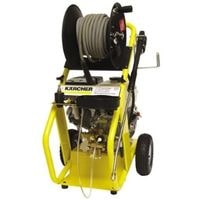Karcher pressure washer common faults. When caring for a home, you are always looking for ways to simplify life. Maybe you’ve fantasized about investing in a pressure washer and just how much time you could save.
You decide to go ahead and purchase the Karcher pressure washer, but now that you have it in your possession, are you really using it the right way?
Common problems may pop up as an owner of any Karcher pressure washer over its lifespan that may be easily fixed with either simple cleaning techniques or calling customer service so they can fix it while you relax.
Karcher pressure washer common faults

Here we will discuss some important solutions for the common Karcher pressure washer common faults.
The Karcher pressure washer is leaking
The thermal release valve may be responsible for the leak. Hot water escapes from the pump when the thermal release valve opens due to excessively high water temperatures.
If a pressure washer is left running without any spray water coming through it for an extended period, then the pump begins to heat up, as does the water within it.
This sort of excessive heat will cause a safety system inside the pressure washer to trigger and open this particular valve, thus causing hot water to flow out.
A Karcher pressure washer may be leaking due to broken pump seals. The pump may need to be replaced or rebuilt.
If you are unfamiliar with the process of replacing a pump, it’s recommended that you seek the help of a professional who is knowledgeable about Kärcher pressure washers.
Karcher pressure washer starts then stalls
Stalls at one point in the pressure washer issue with Karcher could be due to a clogged carburetor.
A clogged carburetor is most common when fuel is left idle for a prolonged amount of time, and the ingredients in the fuel begin to evaporate.
The remaining substances can coagulate, which blocks up the carburetor and prevent it from supplying gas to the engine, causing it to stall out.
Anytime you are cleaning or maintaining your pressure washer from now on, remember to always drain and replace the existing gasoline with new fuel so that you avoid clogging up your engine again.
Karcher Pressure washer’s defective soap injector
Karcher Pressure washer’s defective soap injector issue might be attributed to its chemical injection kit, which requires you to replace the chemical injection kit.
The chemical injection kit contains the parts needed to repair most problems with the Karcher pressure washer.
Karcher Pressure washer starting issue
Sometimes pressure washer won’t start due to a defective ignition coil.
While the engine is running, the ignition coil sends voltage to the spark plug. A defective ignition coil may prevent the engine from starting.
Make sure that the spark plug is working properly before replacing the ignition coil. Check the ignition coil using an ignition coil tester if you have verified that the spark plug is working properly. If it’s defective, replace it.
Karcher Pressure washer has low pressure
Low pressure can occur due to a defective pump. The pump assembly may need to be rebuilt or replaced.
If you notice that the problem is still occurring after replacing the pump, your seals are most likely worn out and will need to be replaced.
If your pressure washer is more than a few years old, you are using it fairly often, and/or you use the washing attachments practically daily, substitute the pump assembly.
If your pressure washer is relatively new and is used sparingly or with the accessory hose only once in a while, either replace the pump gear or replace the pump seals.
Karcher Pressure washer Engine runs roughly
This issue of a pressure washer occurring is caused by a faulty fuel cap. As the fuel is consumed in your gas tank, the pressure inside it rises.
To relieve this pressure, there is a small vent on your gas cap that allows air to enter the chamber. Should this vent be clogged, the engine will not have the ability to function properly and may stall or run roughly.
To determine if this is indeed an issue, slightly loosen the gas cap to allow more room and try starting up your engine again.
If it now still works as intended after this small adjustment, there is a good chance that you’re dealing with a faulty fuel cap.
If there are issues related to having too high pressure in your engine chamber which aren’t being resolved completely with just loosening of your gas cap, you’ll need to replace it for sure.
Related Guides
